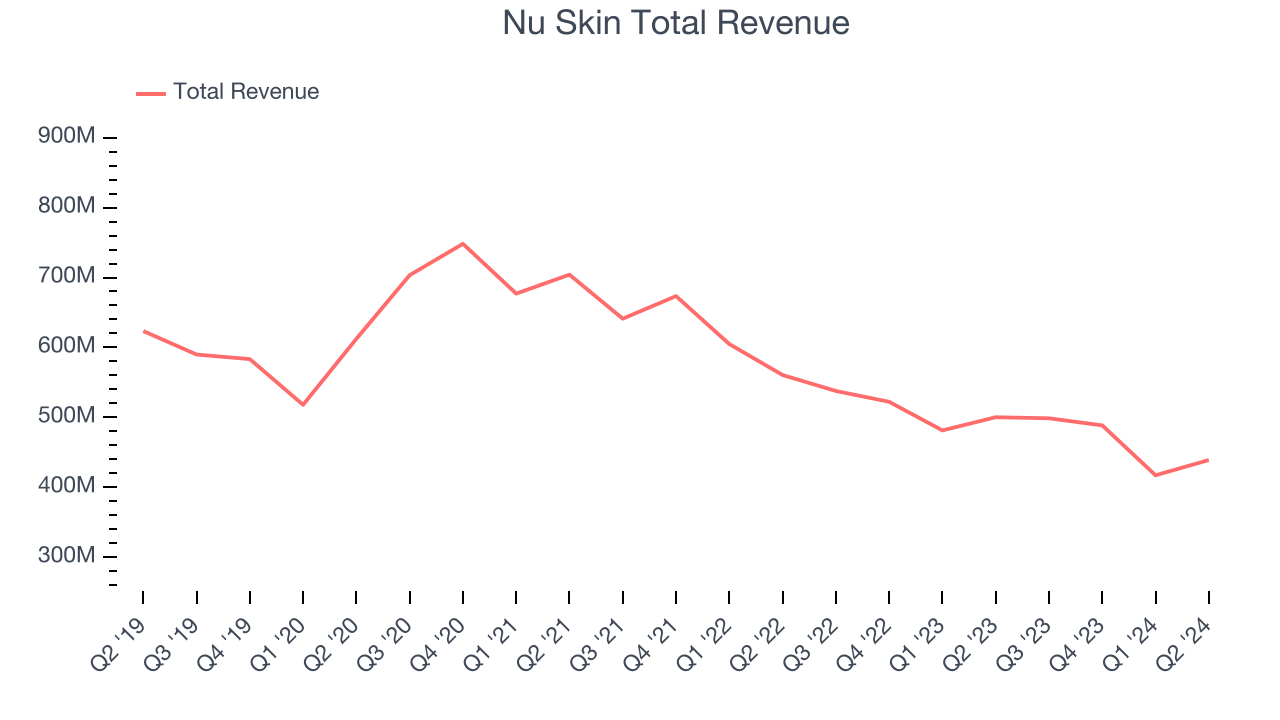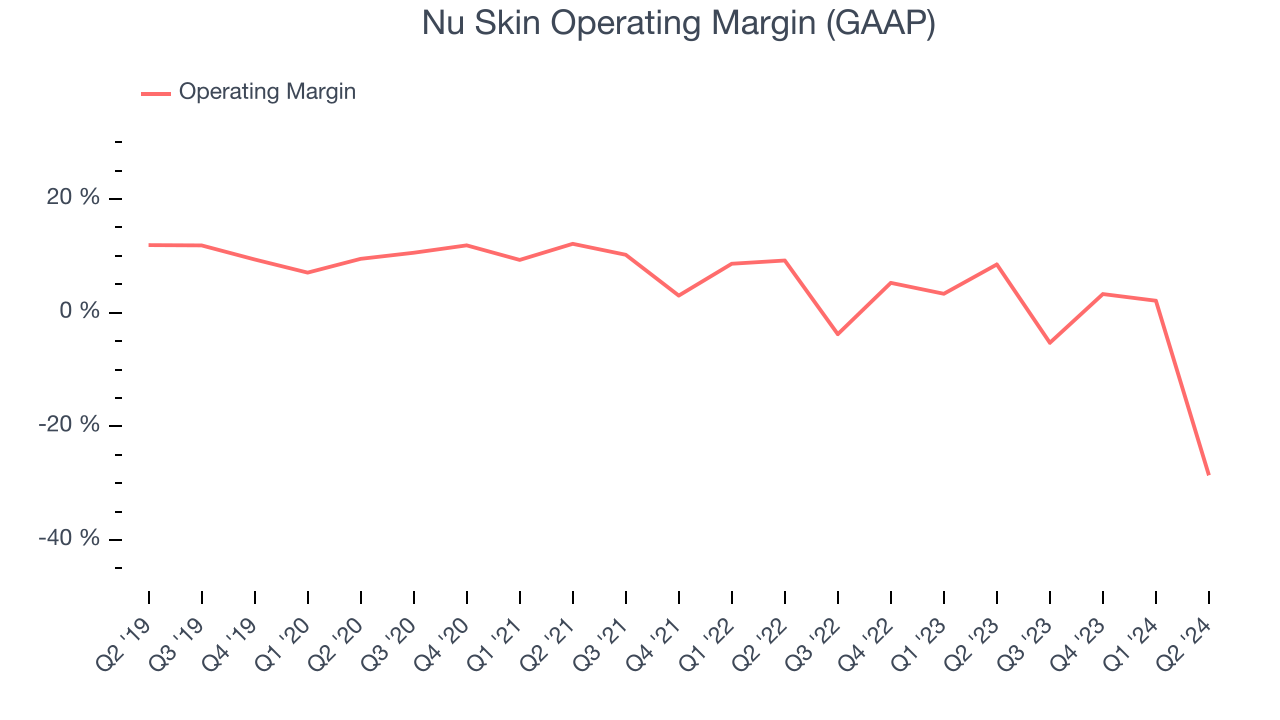Personal care company Nu Skin (NYSE:NUS) beat analysts' expectations in Q2 CY2024, with revenue down 12.2% year on year to $439.1 million. On the other hand, next quarter's revenue guidance of $447.5 million was less impressive, coming in 2.7% below analysts' estimates. It made a non-GAAP profit of $0.21 per share, down from its profit of $0.54 per share in the same quarter last year.
Is now the time to buy Nu Skin? Find out by accessing our full research report, it's free.
Nu Skin (NUS) Q2 CY2024 Highlights:
- Revenue: $439.1 million vs analyst estimates of $431.9 million (1.7% beat)
- EPS (non-GAAP): $0.21 vs analyst estimates of $0.17 (25.6% beat)
- Revenue Guidance for Q3 CY2024 is $447.5 million at the midpoint, below analyst estimates of $459.9 million
- The company dropped its revenue guidance for the full year from $1.8 billion to $1.77 billion at the midpoint, a 1.7% decrease
- EPS (non-GAAP) guidance for Q3 CY2024 is $0.20 at the midpoint, below analyst estimates of $0.42
- EPS (non-GAAP) guidance for the full year is $0.85 at the midpoint, missing analyst estimates by 22.9%
- Gross Margin (GAAP): 70%, down from 72.9% in the same quarter last year
- Market Capitalization: $521 million
With person-to-person marketing and sales rather than selling through retail stores, Nu Skin (NYSE:NUS) is a personal care and dietary supplements company that engages in direct selling.
Personal Care
While personal care products products may seem more discretionary than food, consumers tend to maintain or even boost their spending on the category during tough times. This phenomenon is known as "the lipstick effect" by economists, which states that consumers still want some semblance of affordable luxuries like beauty and wellness when the economy is sputtering. Consumer tastes are constantly changing, and personal care companies are currently responding to the public’s increased desire for ethically produced goods by featuring natural ingredients in their products.
Sales Growth
Nu Skin carries some recognizable brands and products but is a mid-sized consumer staples company. Its size could bring disadvantages compared to larger competitors benefiting from better brand awareness and economies of scale. On the other hand, Nu Skin can still achieve high growth rates because its revenue base is not yet monstrous.
As you can see below, the company's revenue has declined over the last three years, dropping 13.3% annually. This is among the worst in the consumer staples industry, where demand is typically stable.

This quarter, Nu Skin's revenue fell 12.2% year on year to $439.1 million but beat Wall Street's estimates by 1.7%. The company is guiding for a 10.3% year-on-year revenue decline next quarter to $447.5 million, a further deceleration from the 7.3% year-on-year decrease it recorded in the same quarter last year. Looking ahead, Wall Street expects revenue to decline 2.7% over the next 12 months.
When a company has more cash than it knows what to do with, buying back its own shares can make a lot of sense–as long as the price is right. Luckily, we’ve found one, a low-priced stock that is gushing free cash flow AND buying back shares. Click here to claim your Special Free Report on a fallen angel growth story that is already recovering from a setback.
Operating Margin
Operating margin is a key profitability metric for staples companies because it accounts for all expenses enabling a business to operate smoothly, including marketing and advertising, IT systems, wages, and other administrative costs.
Given the industry's stable characteristics, unprofitable publicly traded staples companies are rare. Unfortunately for Nu Skin, it was one of them over the last two years as its high expenses contributed to an average operating margin of negative 1.6%. This result is surprising given its high gross margin as a starting point.
Analyzing the trend in its profitability, Nu Skin's annual operating margin decreased by 10.1 percentage points over the last two years. The company's performance was poor no matter how you look at it. It shows operating expenses were rising and it couldn't pass those costs onto its customers.

In Q2, Nu Skin generated an operating profit margin of negative 28.6%, down 37.1 percentage points year on year. Since Nu Skin's operating margin decreased more than its gross margin, we can assume the company was recently less efficient because expenses such as sales, marketing, and administrative overhead increased.
Key Takeaways from Nu Skin's Q2 Results
We enjoyed seeing Nu Skin exceed analysts' EPS expectations this quarter. We were also glad its revenue outperformed Wall Street's estimates. On the other hand, its full-year earnings forecast missed analysts' expectations and its earnings guidance for next quarter missed Wall Street's estimates. This quarter featured some positives but overall could have been better, and the weak outlook could weigh heavily on shares. The stock remained flat at $10.40 immediately following the results..
So should you invest in Nu Skin right now? When making that decision, it's important to consider its valuation, business qualities, as well as what has happened in the latest quarter. We cover that in our actionable full research report which you can read here, it's free.
